Just beautiful Paul. When one works at the level of a master craftsman one should be called a master craftsman. From my point of view you have reached that skill level and then some!
You are using an out of date browser. It may not display this or other websites correctly.
You should upgrade or use an alternative browser.
You should upgrade or use an alternative browser.
Vasa - 1:65 DeAgostini [COMPLETED BUILD]
- Thread starter dockattner
- Start date
- Watchers 145
Thank you, everyone, for the likes and loves. It keeps me motivated to keep pressing on.
Thanks, also, to Jan @Pathfinder65 , Marc @Hubac’s Historian , Roger @RogerD , Dean @Dean62 , @Lologaditano , Heinrich @Heinrich , Kurt @DARIVS ARCHITECTVS , and Daniel @Daniel20 for each taking the time to post. It is much appreciated.
I have some stepped up responsibilities at my hobby job (my non-paying job) in the near term so there will be a short delay at the Vasa shipyard but don't be concerned - I'll be back when there is something to show.
You have all blessed me with your encouragement as I have seen you do with many others. This forum is quite remarkable.
Thanks, also, to Jan @Pathfinder65 , Marc @Hubac’s Historian , Roger @RogerD , Dean @Dean62 , @Lologaditano , Heinrich @Heinrich , Kurt @DARIVS ARCHITECTVS , and Daniel @Daniel20 for each taking the time to post. It is much appreciated.
I have some stepped up responsibilities at my hobby job (my non-paying job) in the near term so there will be a short delay at the Vasa shipyard but don't be concerned - I'll be back when there is something to show.
You have all blessed me with your encouragement as I have seen you do with many others. This forum is quite remarkable.
Looking forward to seeing you back here soon Paul 
Paul, you definitely have natural ability! You have shown some amazing skills in many areas thus far, especially being new to wood ship model building! You may not have had the knowledge up front concerning technique, but you had the skills. You seem to be good at working with your hands and doing small scale crafting and painting. Model building 101. You just needed a little help with techniques, which you picked up on very quickly, thus supporting my statement that you have natural ability. And you are also a quick study.Thank you, everyone, for the likes and loves. It keeps me motivated to keep pressing on.
Thanks, also, to Jan @Pathfinder65 , Marc @Hubac’s Historian , Roger @RogerD , Dean @Dean62 , @Lologaditano , Heinrich @Heinrich , Kurt @DARIVS ARCHITECTVS , and Daniel @Daniel20 for each taking the time to post. It is much appreciated.
I have some stepped up responsibilities at my hobby job (my non-paying job) in the near term so there will be a short delay at the Vasa shipyard but don't be concerned - I'll be back when there is something to show.
You have all blessed me with your encouragement as I have seen you do with many others. This forum is quite remarkable.
It's like music or art...some are born with the natural ability to excel, while others will never be good at it, no matter how much they try.
The good news is we all have something we are good at, although you don't have to be good at something to enjoy it as a hobby, but it helps .
That said, I suspect you will soon address masts and rigging, the next phase of the build. And I assume you will make your own rope, and learn the art of rigging like you had been doing it all your life...lol. You ARE blessed my friend! Looking forward to your future progress.
Last edited:
Well said, Dean! Great thoughts. The Show Must Going ON! (The Wall, 1979) 
I'd ask you to stop making me jealous of your painting skills, Paul... but you wouldn't listen. Nor should you. Keep up the excellent work. It inspires many. 

Paul,
So much progress since I last looked! Amazing workmanship and precision with your painting of sculptures and deck fittings.
One small detail I would bring to your attention from Post #1,249. On the Vasa, there was no external wheel or tiller. Steering of the rudder was controlled by a very long tiller arm, connected directly to the rudder and extending forward into a cabin below the aft upper deck (see below).
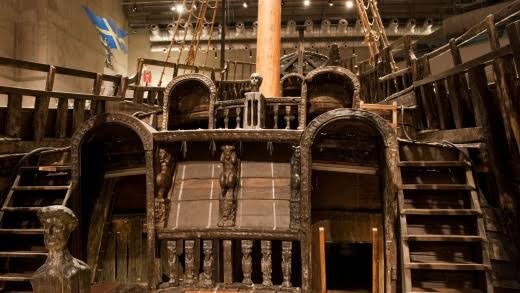
You can see behind the vertical mouldings that this is open into the tiller cabin and allowed the tiller man to see out and receive instructions for steering the ship. Cumbersome I would have thought but this is as it was designed.
I am not being critical, but highlighting a mistake I made too.
Keep up the amazing progress - It is an inspiration to us all!!
PeterG
So much progress since I last looked! Amazing workmanship and precision with your painting of sculptures and deck fittings.
One small detail I would bring to your attention from Post #1,249. On the Vasa, there was no external wheel or tiller. Steering of the rudder was controlled by a very long tiller arm, connected directly to the rudder and extending forward into a cabin below the aft upper deck (see below).

You can see behind the vertical mouldings that this is open into the tiller cabin and allowed the tiller man to see out and receive instructions for steering the ship. Cumbersome I would have thought but this is as it was designed.
I am not being critical, but highlighting a mistake I made too.
Keep up the amazing progress - It is an inspiration to us all!!
PeterG
Don't forget the whipstaff.
Hi Peter,Paul,
So much progress since I last looked! Amazing workmanship and precision with your painting of sculptures and deck fittings.
One small detail I would bring to your attention from Post #1,249. On the Vasa, there was no external wheel or tiller. Steering of the rudder was controlled by a very long tiller arm, connected directly to the rudder and extending forward into a cabin below the aft upper deck (see below).
View attachment 250193
You can see behind the vertical mouldings that this is open into the tiller cabin and allowed the tiller man to see out and receive instructions for steering the ship. Cumbersome I would have thought but this is as it was designed.
I am not being critical, but highlighting a mistake I made too.
Keep up the amazing progress - It is an inspiration to us all!!
PeterG
Thank you so much for looking in on my build and offering your important correction. John (@oldflyer) warned me of this as well and shared with me the photo you posted. I interpreted that image as showing the area half open (port closed - starboard open) but I may be seeing things. In retrospect leaving it completely open would make sense. The helmsman couldn't have seen in front of the ship from this vantage point but perhaps would have been able to see how the sails were filling with wind...having both sides open would provide a better view.
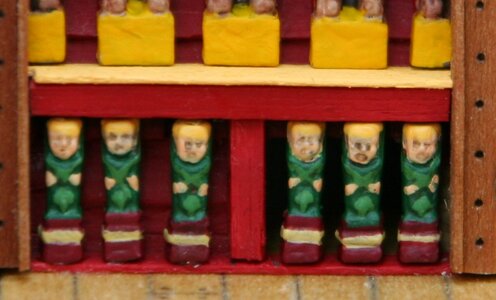
Last edited:
Would you drive your car with your eyes closed ? WAIT. Don't answer that..Hi Peter,
Thank you so much for looking in on my build and offering your important correction. John (@oldflyer) warned me of this as well and shared with me the photo you posted. I interpreted that image as showing the area half open (port closed - starboard open) but I may be seeing things. In retrospect leaving it completely open would make sense. The helmsman couldn't have seen in front of the ship from this vantagepoint but perhaps would have been able to see how the sails were filling with wind...having both sides open would provide a better view.
View attachment 250345
Seriously, Paul, unless there's a raging storm outside which could blind or impede the helmsman, the shutters should be open. With the shutters closed, the helmsman can still receive orders from men above without getting soaking wet and cold in stormy weather. Plus, if they are open, you may be able to view the whipstaff on the model.
Its only the part on the very bottom (by the 6 vertical green dudes) that is open. I have half of it open because that's what I think I see in the picture from the actual ship. The part by the 'bears' is closed and fixed in place and never open. Or maybe I'm not understanding what you are saying???Seriously, Paul, unless there's a raging storm outside which could blind or impede the helmsman, the shutters should be open. With the shutters closed, the helmsman can still receive orders from men above without getting soaking wet and cold in stormy weather. Plus, if they are open, you may be able to view the whipstaff on the model.
This discussion has sent me searching for more pictures. The following is from the 1:10...
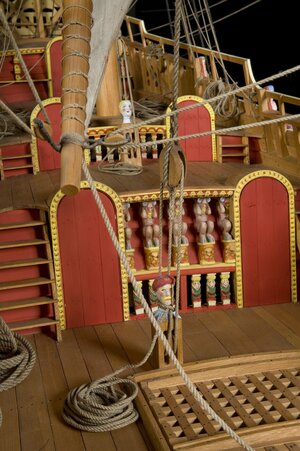
And here is Fred Hocker at the helmsman's position on the ship:
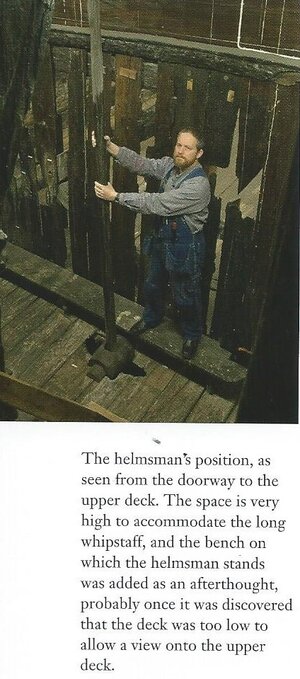
Credit: Vasa - A Swedish Warship by Fred Hocker, Medstroms Bokforlag and Oxbow Books (though Fred uses this picture as his avatar so it is widely seen - at least among Vasa geeks).
The helmsman had a binnacle with compass and some daylight passing between some carved statuary - that's about it. He IS driving with his eyes closed
Paul,
You are correct that it would have been extremely difficult to steer the ship from the helmsman’s position with limited vision and so deep in the ship. My understanding was that the helmsman’s steering was therefore not so much visual as audible. I think having the open slats, between the lower green figurines, was more so he could HEAR instructions rather than see to steer.
The other thing too of course, being directly below the main deck, any water over the deck could wash into the cabin in bad weather- not great design in my opinion.
The final thing as Darivs highlights, is that with the opening available, the whipstaff could certainly be seen from the outside, (a difficult thing to add now with the cabin enclosed), but great for the grandkids and friends when you are explaining how the ship was sailed!!
As a last point, somewhere (and I cannot find the link now), I have seen a virtual 3D rendering of this part of the ship and inside this cabin. It definitely showed visible, forward viewing of the deck area, but not further forward.
PeterG
You are correct that it would have been extremely difficult to steer the ship from the helmsman’s position with limited vision and so deep in the ship. My understanding was that the helmsman’s steering was therefore not so much visual as audible. I think having the open slats, between the lower green figurines, was more so he could HEAR instructions rather than see to steer.
The other thing too of course, being directly below the main deck, any water over the deck could wash into the cabin in bad weather- not great design in my opinion.
The final thing as Darivs highlights, is that with the opening available, the whipstaff could certainly be seen from the outside, (a difficult thing to add now with the cabin enclosed), but great for the grandkids and friends when you are explaining how the ship was sailed!!
As a last point, somewhere (and I cannot find the link now), I have seen a virtual 3D rendering of this part of the ship and inside this cabin. It definitely showed visible, forward viewing of the deck area, but not further forward.
PeterG
If anyone is interested in seeing the 3D rendering PeterG just mentioned see post #112 in this build log. It is AMAZING!Paul,
You are correct that it would have been extremely difficult to steer the ship from the helmsman’s position with limited vision and so deep in the ship. My understanding was that the helmsman’s steering was therefore not so much visual as audible. I think having the open slats, between the lower green figurines, was more so he could HEAR instructions rather than see to steer.
The other thing too of course, being directly below the main deck, any water over the deck could wash into the cabin in bad weather- not great design in my opinion.
The final thing as Darivs highlights, is that with the opening available, the whipstaff could certainly be seen from the outside, (a difficult thing to add now with the cabin enclosed), but great for the grandkids and friends when you are explaining how the ship was sailed!!
As a last point, somewhere (and I cannot find the link now), I have seen a virtual 3D rendering of this part of the ship and inside this cabin. It definitely showed visible, forward viewing of the deck area, but not further forward.
PeterG
Paul,
Below is a screen capture from the 3D site.
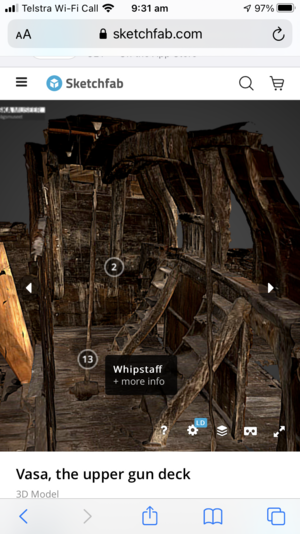
This shows the two companionways leading into the steerage cabin, the whipstaff plus the forward figurines. In the 3D rendering, you cannot see through these figures!!
This is a great site to see the internals of the ship (at least the section beneath the main deck).
Still not a nice place to have worked!!
PeterG
Below is a screen capture from the 3D site.

This shows the two companionways leading into the steerage cabin, the whipstaff plus the forward figurines. In the 3D rendering, you cannot see through these figures!!
This is a great site to see the internals of the ship (at least the section beneath the main deck).
Still not a nice place to have worked!!
PeterG
Good day Paul!
Despite all difficulties of building You mentioned ,She is steady groving up, and becomes more and more beautiful day by day! ))
))
Nice job Paul!
By the way,
all bulkheads on Vasa, must be clincer build , including beackhead bulkhead, as I could see on (photoes)original Vasa in museum, plus as could be seen, here some additional steps arranged, on both sides and in central part of the bulckhead...
I mentioned it, because they are eye catching details...
Despite all difficulties of building You mentioned ,She is steady groving up, and becomes more and more beautiful day by day!
Nice job Paul!
By the way,
all bulkheads on Vasa, must be clincer build , including beackhead bulkhead, as I could see on (photoes)original Vasa in museum, plus as could be seen, here some additional steps arranged, on both sides and in central part of the bulckhead...
I mentioned it, because they are eye catching details...
Hi Kirill,Good day Paul!
Despite all difficulties of building You mentioned ,She is steady groving up, and becomes more and more beautiful day by day!))
Nice job Paul!
By the way,
all bulkheads on Vasa, must be clincer build , including beackhead bulkhead, as I could see on (photoes)original Vasa in museum, plus as could be seen, here some additional steps arranged, on both sides and in central part of the bulckhead...
I mentioned it, because they are eye catching details...
Thank you for stopping by. Yes, I have clinker planking everywhere but the beakhead bulkhead. I agree with you that the photos of the actual ship show clinker planking there but I believe once the steps are in place (which I will include - or at least that's my plan) they will effectively hide the planking in that area. None of these details are represented in the kit so I'll need to design and fabricate my own solution... But before any of that happens I need to sort out the beakhead/galleon so the steps end up in the right place.
Thanks Paul,
Yesterday I went to the same opinion, as Yours... that steps,when fitted, will hide actual planking configuration... on the real Vasa photoes, we could see( clinker) them only in the corners?...so, actually it will not be so remarkable, and of couse , all these small items could be point of attention for a few people only... ))
))
Good Luck with Beauty building...!!!
Yesterday I went to the same opinion, as Yours... that steps,when fitted, will hide actual planking configuration... on the real Vasa photoes, we could see( clinker) them only in the corners?...so, actually it will not be so remarkable, and of couse , all these small items could be point of attention for a few people only...
Good Luck with Beauty building...!!!
Keep in mind that at the scale of the model, the planks would be so thin that the clinker steps would be very subtle indeed.
No problem, Paul, your short delay. Do I have time to go through your build log again. I am more and more impressed with what you have built so far. A beautiful hull, carving and painting.
And thanks to the fresh look of that colleague of yours, I think you now look just a little differently to your model.
Regards, Peter
And thanks to the fresh look of that colleague of yours, I think you now look just a little differently to your model.
Regards, Peter






